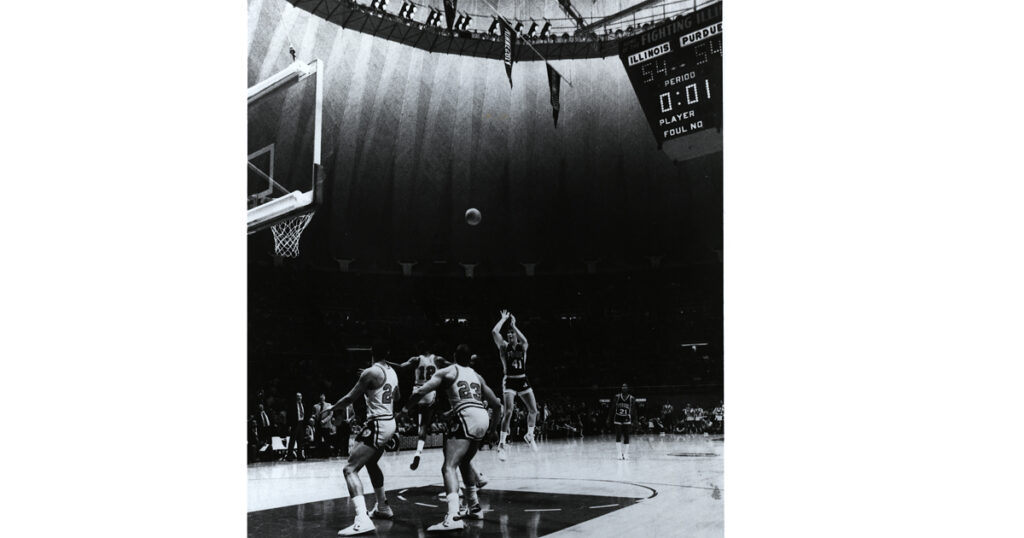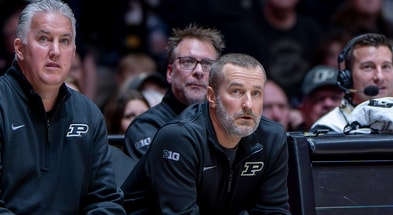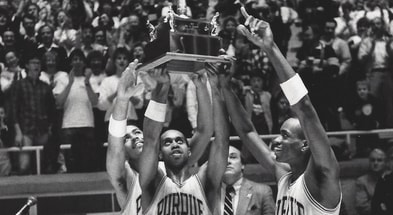Memories of Purdue great Jim Rowinski

I will admit it took me a few days to gather my thoughts on the recent passing of Purdue legend Jim Rowinski last week at the age of 63.
Words like “too young” came to mind, which happens when someone passes before their presumed time. But the story of Rowinski and his role in Purdue men’s basketball history must be told to those who started following the Boilermakers until the 1990s. It also needs to be refreshed to long-time fans who remember “Row” and his magical journey from walk-on to 1984 Big Ten MVP.

It is a story every bit as improbable as the one Purdue fans and the college basketball world are experiencing now with soon-to-be two-time college basketball player-of-the-year Zach Edey.
The list of substantial roadblocks put in front of Rowinski, who was a 6-foot-8 center for coach Gene Keady’s first Big Ten title team, is long. Standing just 6-feet tall as a junior in high school, he was cut from his Long Island, N.Y., Syosset High School team. He grew three inches and as a senior was good enough to get some small college offers. Rowinski’s dad was a Purdue engineering grad and his sister was already enrolled at Purdue (she was on the crew team), so coming to Purdue was always in Rowinski’s mind.
His climb would be steep to even make Purdue’s team. He wasn’t even close to being a preferred walk-on. The fact that coach Lee Rose told him he would have a chance to try out was enough for him. Not a chance to make the team, but a chance to try out, mind you.
So, in October of his freshman year, Rowinski got up at 6 a.m. and went to Mackey to try out. He earned a spot on Rose’s Renegade squad, a group of Purdue basketball-loving students brought on to mimic the opposition. He made enough of an impression that when Rose left Purdue for South Florida the following spring after taking the Boilermakers to the 1980 Final Four, he recommended Rowinski to Keady as he took over the program.
“I feel fortunate that Coach Rose took the time to speak with Coach Keady, and I am grateful that Coach Keady took the recommendation,” Rowinski said in his interview with GoldandBlack.com (see below) last February.
“I owed a lot to both of them.”
That was the thing about Rowinski that I remember most, as I was a student basketball manager then. He was always grateful and downplayed any of his accomplishments.
Less than two years later and still without a scholarship, Rowinski worked his way into the starting lineup, drawing his first assignment against a raw freshman at Houston named Hakeem Olajuwon. Rowinski, who had grown to 6-8 but weighed only 197 pounds, out-rebounded and outplayed Olajuwon, grabbing 10 boards in his first start in a Sugar Bowl Tournament game played in the Superdome. But by the time Rowinski left New Orleans, he had a stress fracture that ended his sophomore season.
Rowinski played the long game at Purdue
Once again, Rowinski’s looked at it as a serendipitous setback. His short-term disappointment was turned into a long-term benefit. Forced to the bench for the remainder of the year, Rowinski put his weightlifting regiment into high gear.
But by the time he was back for the 1983 season, Rowinski had not only switched his jersey number from 12 to 41 but also gained 30 pounds and a bunch of muscle. His junior year saw primarily a backup role, thought he did have five starts, appeared in 25 of 30 games and averaged about 11 minutes of court time per contest.
Yet, despite his memorable senior year, his most memorable moment happened in the last seconds of win at Illinois; the biggest comeback in Purdue history, when Rowinski banked in the game winner at the buzzer to complete the Boilermakers’ 18-0 run over the game’s final 9:38 to post a 56-54 victory.
“I called ‘bank’ ” said Rowinski totally serious about the most notable last-second game-winning shot in Purdue history.
Purdue ended the 1982-83 season with Keady’s first trip to the NCAA Tournament, losing to Arkansas in a hard-fought Round of 32 contest. Rowinski played well against the Razorbacks, having the look of a contributor his senior year. But it took Russell Cross becoming Purdue’s first “hardship case” to the NBA for Rowinski to get his chance to crack the starting lineup for good.
“People forget that if Russell stays for his senior year, Jim would have never earned a starting spot,” said Bruce Weber, who was Keady’s assistant at the time. “He made the most of his opportunity. Jim was just a hard-working great person, and he refused to be denied.”
Top 10
- 1New
YouTube TV
Puts ESPN, Disney on blast
- 2Hot
College GameDay
McAfee reveals way to watch
- 3Trending
Kenny Dillingham
Addresses future at ASU
- 4
YouTube TV, ESPN dispute
New update for Week 11
- 5
Luke Fickell
Wisconsin makes decision
Get the Daily On3 Newsletter in your inbox every morning
By clicking "Subscribe to Newsletter", I agree to On3's Privacy Notice, Terms, and use of my personal information described therein.

Purdue took advantage of a European trip, and despite being picked ninth by the experts prior to the 1983-84 campaign.
“We had some great seniors and upperclassmen on that team, I knew we would be better than people thought,” said Rowinski when referencing fellow seniors Greg Eifert, Curt Clawson and Ricky Hall and experienced juniors Steve Reid and James Bullock. “We were a together unit and it showed.”
Purdue went on to prove the experts wrong and win a share of the Big Ten crown with Illinois. In the home contest versus the Illini, Mackey was in rare form and Rowinski lived up to the task. His 24-point, 13-rebound performance earned him a feature as the “Prince of Pecs” the following week in Sports Illustrated.
“I was fortunate to have a good game, especially in the second half when I had 20 points and 10 rebounds,” Rowinski said. “We had a lot of good stories on our team, I was just one of them.”
While true, that might have been the understatement of the year. Rowinski became the second Boilermaker (RIck Mount) to win the Chicago Tribune Silver Basketball as the Big Ten’s MVP for his efforts.
The Purdue basketball stories are great, but Rowinski was a special dude
Rowinski had a cup-of-coffee NBA career with brief stints with the Sixers, Pistons and Heat. He played for years overseas and in the CBA (the G-League of its days). But he never lost his passion for basketball. He had a passion for horse racing, never missing the Belmont Stakes that took place close to his New York home. He had a career in personnel placing physicians in geographic areas of need first doing it from the New York area and then finally in Fort Lauderdale, Fla., his final location.
He overcame bullying by teammates, something I saw as the senior manager on the 1981-82 team when a couple of seniors were relentless on Rowinski, who had a hard time keeping up in updated clothes because he was growing over an inch or year. Still, he managed to always be upbeat. He was so proud of his New York background, but never played the tough guy off the court.
He was quirky. A basketball manager colleague of mine reminded me he always used to jump rope backward because he couldn’t, for some reason, turn his wrists forward. He marched to the beat of his own drum.
In that same 1981-82 season when he was rehabbing from his stress fracture, Jim was nice enough to show me around New York City on my first trip to the Big Apple. He even introduced me to OTB (off-track betting). It’s something I haven’t done since. We had a blast in NYC, despite the Boilermakers losing the title game to Bradley in Keady’s second year.
But what surprised me was that Rowinski, 41 years later, remembered our OTB experience and our rides with gypsy cabbies that Rowinski knew how to negotiate and navigate.
I was just a manager, and he was a Big Ten MVP. We hadn’t connected in decades. But he remembered.
I will never forget that he remembered. And, I will never forget Jim Rowinski.
RIP Jim.





















